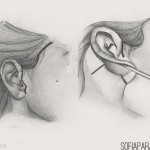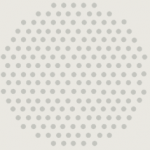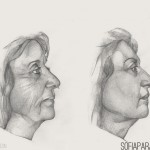Aging of the face results in a number of typical features and affect the forehead, eyebrows, eyelids, cheek, jaw and neck areas. It is due to loss of skin elasticity and the effect of gravity on the face. People that have had a lot of sun exposure will often show signs of facial aging at an earlier stage.
The most common effects are the loss of the youthful curve of the cheek and jaws, deepening of the lines running from the base of the nose to the corners of the mouth (nasolabial folds), loose skin and bands in the neck. Not all people age in the same way and therefore the proposed surgery has to be tailored to individual needs.
The operation
The extent of the surgery depends on the individual need. If the problem is the upper face or eyes then a browlift or eyelid reduction may be indicated. (See sections on blepharoplasty, browlift). Mild cases with wrinkles of the forehead, between the eyebrows and around the eyes can be also treated conservatively with laser resurfacing, microneedling, chemical peels, botox and hyaluronic acid. (See sections on laser resurfacing, chemical peels, microneedling, botox and hyaluronic acid).
For the mid-and lower face and neck problems the incision lines will start in or behind the temporal hairline, curve around the front and back of the ear and then extend into the hair at the back of the ear. This will allow the surgeon access to tighten the muscle layer (SMAS) of the face and neck as well as excising any extra skin.
Sometimes a small incision under the chin will allow removal of fat, and tightening of the muscle in this area. Surgery is performed under general anaesthesia and the patient typically stays in the hospital for one night at least.
Consequences and complications
The facial skin will feel numb in the first 6 weeks to 3 months after the surgery. Swelling and bruising can last up to 2-3 weeks. The temporal hairline may start higher up in front of the ear after the surgery and male patients may have to shave behind their ears as beard skin is transported to that area. Any of the following rare complications can occur:
• Collection of blood under the facial skin from a ruptured blood vessel
• Infection
• Rarely – damage to the nerve that moves a part of the face – this takes a few months to recover
• If you a prone to keloid (thickened scars) then this may happen on the face too
• Heavy smokers can have problems with healing of the skin in front and behind the ears
After the surgery
You carry 2 drains -one from each side of the face), which are usually removed 24 hours after the operation. The sutures are normally removed 12 days after the surgery at which stage most of the swelling and bruising will be gone. The postoperative result can be judged after 3 months postoperatively. Lifting of heavy objects or hard physical activity is not recommended during the first two weeks after the surgery.
You can wash your hair backwards in the shower or with a hand shower but do not bend forward. All aspirin and any other blood thinning tablets should be stopped before the surgery and avoided in the immediate period after the surgery.
Most of the discomfort after the surgery is due to the tightness of the skin caused by the swelling. Pain is normally moderate. Avoid hair dyeing during the first month after surgery.



